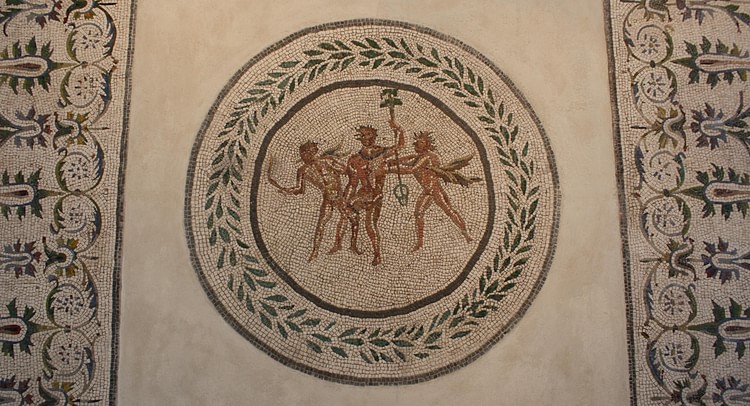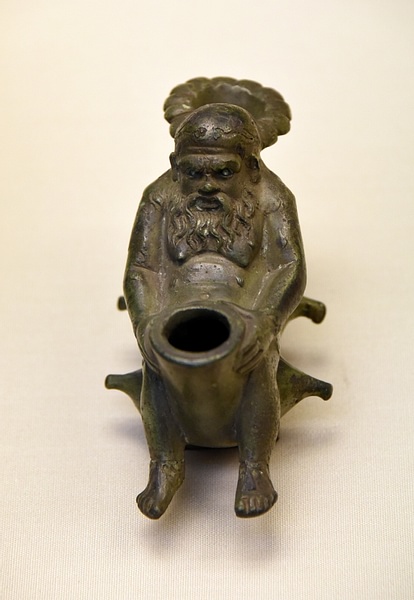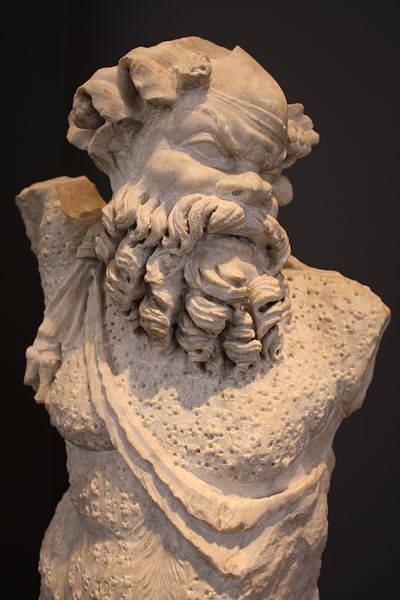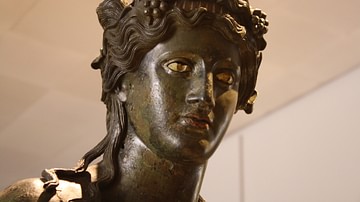
Silenus (also spelt Silenos) is a rustic god of the forest, drunkenness and wine-making in Greek mythology. He is best known as the companion and foster father of the god Dionysos. Silenus is closely associated with the satyrs, sometimes listed as the oldest and the wisest satyr.
Silenus is represented as a contradictory figure in ancient sources. On the one hand, he is generally depicted in Greek art as being drunk and enjoying a debauchery lifestyle, but on the other hand, he is also considered to be extremely wise and can tell the future and past of anyone he comes across. Despite his drunken nature and appearance, he was generally a well-loved figure in the ancient world.
Birth & Family
Silenus was born at Malea (modern-day Cape Maleas), and, according to some sources, was the son of Hermes and Gaia (Earth) or the pastoral god, Pan. Silenus was the father of Maron, Astraeus and the wise centaur, Pholus, who he fathered with an ash tree nymph (Meliae).
In Art
Although Silenus was considered the wisest and most powerful of the satyrs, he was given a very human-like appearance in art. Silenus was depicted as a plump, balding man with a round belly, a beard and an upturned nose. He was often holding a goblet of wine or riding his mule and was almost always shown as being drunk. He was also often depicted alongside Dionysos and the other satyrs.
Silenus & the Satyrs
The satyrs are half-men, half-beast creatures, often depicted with a human's upper body and a goat's or horse's lower body. The younger satyrs often had a human head and chest with a goat's horns, tail, and legs. Older satyrs (known as sileni) had a human upper body with horse's ears and the tail and legs of a horse. Hesiod (c. 700 BCE) described the satyrs as being brothers of the nymphs.
Satyrs were known for their love of wine and wild sexual desires. Silenus was said to be the oldest, wisest and most powerful of the satyrs or is sometimes listed as their grandfather. Although he is widely considered the most well-known satyr (along with Marsyas), Silenus is the only satyr in some sources.
The sileni sometimes referred to a group of rural gods who personified rivers and springs, who, over time, became integrated with the satyrs.
Companion to Dionysos
Dionysos was the son of Zeus and the mortal Semele. After Semele died while pregnant with Dionysos, Zeus removed the baby from her womb, placed him in his thigh, and gave birth to Dionysos himself. After Dionysos had been the target of Hera's wrath, Zeus instructed Hermes to transform Dionysos into a kid or ram and took him to Mount Nysa, where he was cared for by Silenus and the nymphs Nysa, Erato, Macris, and Bacche. He was raised in a cave and fed on honey while Silenus tutored him and taught him to enjoy a love for wine, dancing, and singing. Mount Nysa is where wine was said to have been discovered or invented.
After Dionysos grew up, Hera found him and recognised him as Zeus' son and drove him mad. He wandered the earth in his madness and was accompanied by Silenus and a rowdy group of satyrs and maenads who followed him wherever he went.
The Giants' Revolt
During the Giants' Revolt (a battle between the Olympian gods and the Giants), Silenus fought alongside Dionysos. Silenus and the satyrs rode into the battle on their mules and brayed in terror when they saw the Giants. In turn, the Giants were said to be so alarmed by their braying that they fled in terror. Silenus killed the Giant Enceladus during the battle.
Silenus & King Midas
Midas was a king of Phrygia in Asia Minor (modern-day Turkey) who is most famous for his 'golden touch'. One day, as Silenus marched with the Dionysian army, he strayed away and fell into a drunken stupor in a rose garden. He was found by Phrygian peasants and led before King Midas. Midas, who had been taught the Dionysiac rites by Orpheus, was honoured to have Silenus in his company. Silenus told King Midas many fantastical stories about a large, mysterious continent that lay far beyond any known landmass. He also spoke about a powerful whirlpool that was too dangerous for any traveller to pass. Finally, he mentioned two streams with magical trees that bore fruit. The fruit from the first tree caused great pain and eventual death to whoever ate it, while the fruit from the second tree caused people to age backwards until they disappeared.
King Midas was fascinated by these embellished tales and threw a feast in Silenus' honour, which lasted for ten days and nights. After these ten days, Midas escorted Silenus back to Dionysos. Dionysos had been anxiously awaiting news about Silenus and was overjoyed to see him again. He asked Midas how he wanted to be rewarded, and Midas wished for everything he touched to be turned into gold. Of course, this meant that the food and water he touched also turned into gold and could not be consumed. Midas begged for his wish to be reversed as he was slowly dying from hunger and thirst. He was instructed to visit the source of the river Pactolus and wash himself, after which his golden touch disappeared.
In another, less famous version of the myth, Midas trapped Silenus by filling a well in his garden with wine. After capturing him, Midas forced Silenus to reveal his wisdom so he could be freed. Silenus told Midas that the happiest humans are those that are never born, and if they are born, they are happiest if they die young.
Pomona's Admirers
Pomona is the goddess of fruit and was a skilled gardener, showing a great passion for orchards and fruit trees. She feared being pursued or assaulted by peasants and built a large fence around her orchard to avoid contact with all men. The satyrs, including Silenus, who acted far too young for his years, did all they could to possess her, leering and dancing to try and impress her.
The Discovery of Bees
According to Ovid (43 BCE to 17 CE) in his Fasti, Dionysos was the discoverer of honey and bees. As he tells it, the satyrs were being rowdy as usual, making lots of noise by smashing their cymbals together. Attracted by the noise, a swarm of bees appeared and followed the loud sound. Dionysos and the satyrs were curious as they had never seen bees before and had no idea what they were. So Dionysos collected the bees and placed them in the hollow of a tree, where they produced honey.
Silenus and the satyrs tasted the delicious honey and tried to discover where it had come from. Silenus heard the buzzing of the bees and found the honeycomb in the tree's hollow. However, he pretended to be clueless about where the honey had come from and snuck off on his mule to help himself to some more. Once he had approached the tree, the bees flew out and stung him on his bald head. He fell off his mule and was kicked. Silenus called for help, and Dionysos and the satyrs found him lying on the ground, covered in bee stings and laughed at his plight. Dionysos took pity on Silenus and showed him how to cover his stings with mud to bring down the swelling.
Silenus in Cyclops
Silenus is featured in Euripides' (c. 484-407 BCE) satyr play, a Greek comedy with a chorus that talks about the life of the satyrs. In Cyclops, Silenus is portrayed as a servant of the Cyclops Polyphemus, who Odysseus comes across on his long journey home from the Trojan War. Silenus was on a ship pursuing the kidnappers of Dionysos when his boat was blown off course. He ended up on Polyphemus' island, where he was captured and made to serve him.
Worship & Legacy
Silenus has an Orphic hymn dedicated to him:
Hear me, foster father
of Bacchos, father and nurturer,
best of the Silenoi,
honoured by all the gods,
honoured by mortal men
in the same triennial feasts.
Pure and prized marshal
of the pastoral band,
wakeful reveler and companion
of the fair-girt nurses,
leader of the ivy-crowned
Naiads and of the Bacchantes,
take all the Satyrs,
Half-men, half-beast,
come howling
to the Bacchic lord.
The Bacchantes escort
the holy Lenaian procession
in sacred litanies
revealing torch-lit rites,
Shouting, thyrsos-loving
finding calm in the revels.(The Orphic Hymns: Hymn to Silenos Satyros and the Bacchae, 54.1-10).
In his Description of Greece, Pausanias (c. 115 to c. 180 CE) talks about a temple dedicated to Silenus in the marketplace of Elis (Olympia). This temple was sacred to Silenus alone and was not associated with Dionysos. In the temple, Methe, the personification of drunkenness, can be seen offering him a goblet filled with wine. At Pyrrichos (Laconia), some people believed that Silenus came from Malea to build the town, and there was a well in the marketplace that was given to them by Silenus. If this well ever dried up, they would have a water shortage. In Athens, there was a small stone on the Athenian Acropolis which is said to have been where Silenus sat and rested while he waited for Dionysos.
There have been many works throughout history that feature a drunk yet endearing older man, with the most famous example being the character of Sir John Falstaff, who is seen in a few of William Shakespeare's (1564-1616 CE) plays. William Shakespeare often found inspiration in the pages of history and mythology, so this idea is plausible.













